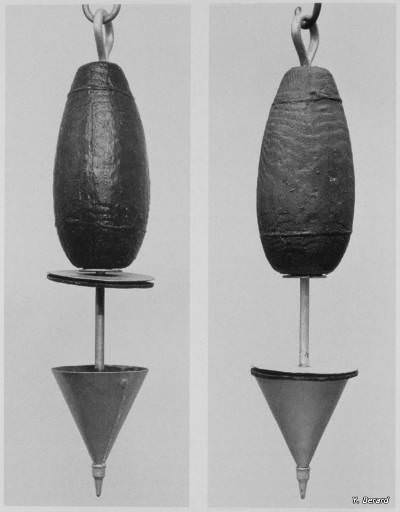Stellwagen's Sounding Cup
The following information is excerpted from Reports of the Superintendent of the Coast Survey.
Report of the Superintendent for 1860

For obtaining specimens of the bottom - The only satisfactory test of having reached the bottom of the sea at considerable depths being the bringing up of a specimen, this has been a subject of constant study with us. The different instruments invented by Lieutenant Stellwagen, Commander Sands, Lieutenant Craven, Lieutenant Berryman, Lieutenant Brooke, and other officers of our navy, are all in use for different kinds of bottom, and according to preference given by different hydrographic chiefs.
The one most commonly used in these explorations has been Lieutenant Stellwagen's invention - a cup placed below the sounding lead, covered by a valve of leather, which slides up the stem of the cup and opens when the lead is descending, closing when it is raised. The weight of the lead, and the turning of the cord generally, suffice to sink the cup into the bottom, filling it; and when the valve is made to close tightly by a piece of flexible leather below the stiff disk, the specimen is not washed out as the lead is drawn up.
In Commander Sands's sounding apparatus a spring keeps an outer cylinder over an opening in an inner hollow one, until it reaches the bottom, when the outer cylinder is forced upwards, and the opening at the side of the inner one, which, having a conical termination, penetrates the bottom, permitting a specimen of the bottom to pass in. On raising the lead the spring forces the outer cylinder over the opening, preventing the specimen from being washed out. The only very deep soundings being, as a general rule, in soft bottom, Sands's specimen cylinder is admirably adapted to that class of work.
Appendix No. 17. Lecture on the Gulf Stream, prepared at the request of the American Association for the Advancement of Science. By A.D. Bache, Supt. U.S. Coast Survey. pp. 167-168.
Report of the Superintendent for 1854
"Among the instruments of every-day use in our work, to which much ingenuity has been applied, is that for bringing up specimens of the bottom of the sea. The use of Stellwagen's lead is common in all our parties, and the apparatus meets with general approval. Lieut. Comg. Craven has invented a box for bringing up deep-sea specimens while running lines, which is convenient and efficacious.... To the same officer we owe an adaptation of the Massey's lead to very deep soundings, which is in the highest degree important, and the use of which has served to bring out in bold relief the imperfection of the ordinary sounding-line when thus applied. Lieut. Comg. Craven has also made an instrument for measuring the set and drift of submarine currents, which he is engaged in perfecting by experiment. In this connection, I should mention, also, the ingenious syphon tide-gauge of Lieut. Comg. Stellwagen, a model of which he has successfully tried, and which he is now authorized to put up on the full scale for a regular working trial...." pg. 13.

